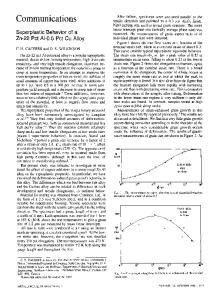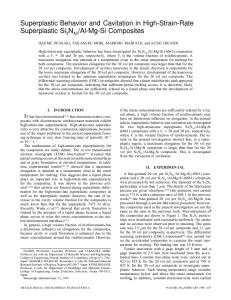Evidence for cavitation in superplastic Zn-22 pct Ai of very high purity
- PDF / 653,405 Bytes
- 3 Pages / 613 x 788.28 pts Page_size
- 98 Downloads / 332 Views
I
22
Wt %
Ni
I000 A O O /
I-
//// 500
I
14 WI %
O 0.O
Ni
I000
t
9"CM
/
M3C
/ ~'
5OO
/
I
0
0.0
I
0.5 Carbon (a)
1.0
I
18.4
1.5
(wt. pct.) I
Wt %
Ni
i
IOOC
50O
~i0
I 0.5
I I .0 Carbon (wt. pct.) (c)
1.5
m e t a l with H(298) = 0 and that for c a r b o n is a c ~ atom r a t i o of C in a n i n f i n i t e l y dilute b i n a r y F e - C alloy.) The s o l u b i l i t y of C in y s a t u r a t e d with M3C was calculated f r o m the free e n e r g y of 73 and that of M3C, obtained by e x t r a p o l a t i o n as d e s c r i b e d above. The computed s o l u b i l i t i e s for t h r e e alloys with 14, 18.4, and 22 wt pct Ni a r e p r e s e n t e d in F i g . 2. T h e y a r e s u b s t a n t i a l l y l a r g e r than the s o l u b i l i t i e s of Cm or g r a p h i t e . 1,7 The t h e r m o d y n a m i c d r i v i n g f o r c e for the f o r m a t i o n of M3C would be low or even a b s e n t in the i s o t h e r m a l a n n e a l s conducted by R o m i g and Golds t e i n . T h i s may be an i m p o r t a n t r e a s o n for t h e i r obs e r v a t i o n of the f o r m a t i o n of graphite i n s t e a d of MsC during isothermal annealing. T h i s work was supported by the National Science F o u n d a t i o n u n d e r G r a n t DMR77-08688. 1. A. D. Romig and J. I. Goldstein: Met. Trans., 1978, vol. 9A, pp. 1599-1609. 2. M. H. Wells: ActaMet., 1964, vol. 12, pp. 389-99. 3. M. M. Rao, R. J. Russet, and P. G. Winchell: Tran~ TMS-AIME, 1967, vol. 239, pp. 634-42. 4. F. D. Richardson: J.LS.I., 1953, vol. 185, pp. 33-51. 5. S. Nagakura: J. Phys. Sac. Japan, 1958, vol. 13, pp. 1005-14. 6. Mats HiUert and Mats Waldenstrom: Calphad, 1977, vol. 1, pp. 97-132. 7. T. Wada, H. Wada, J. F. Elliott, and J. Chipman: Met. Trans., 1971, vol. 2, pp. 2199-2208.
Evidence for Cavitation in Superplastic Zn-22 Pct AI of Very High Purity DAVID A. M I L L E R AND T E R E N C E G. LANGDON
I
I
0.5 I .O 1.5 Carbon (wt. pet.) (b) Fig. 2--Solubility of C in austenite saturated with graphite (G) ,~ cementite with nickel partitioning (C m)1 and cementite without nickel partitioning (M3C) as calculated: (a) 14.0 wt pct Ni, (b) 18.4 wt pct Ni, (c) 22.0 wt pct Ni. 1 6 8 8 - V O L U M E 9A, NOVEMBER 1978
The m a c r o s c o p i c f r a c t u r e c h a r a c t e r i s t i c s m a y be used to divide s u p e r p l a s t i c m a t e r i a l s into two d i s t i n c t g r o u p s . W h e r e a s m a t e r i a l s such as c o m m e r c i a l Cu alloys and m i c r o d u p l e x s t e e l s g e n e r a l l y exhibit s t r a i n s to f a i l u r e of ~200 to 1000 pct and f i n a l f r a c t u r e s u r f a c e s of s u b s t a n t i a l c r o s s - s e c t i o n a l a r e a , alloys such a s P b - 6 2 pct Sn and Z n - 2 2 pct A1 u s u a l l y DAVID A. MILLER and TERENCE G. LANGDONare Research Associate and Professor, respectively, Department of Materials Science, University of Southern California, Los Angeles,CA 90007. Manuscript submitted March 27, 1978.
ISSN 0360-2133/78/1113-1688500.75/0 9 1978AMERICANSOCIETYFOR ME
Data Loading...











